it was a little difficult despite being a long activity but you learn
ACTIVITIES TO WORK WITH THE BOOK BEAUTIFUL GIRL FROM THE RIBBON TIE
STORY: BEAUTIFUL RIBBON TIE GIRL – Ana Maria Machado
Origin of the book according to Ana Maria Machado herself
“This book, for me, is a story that grew out of a game I played with my newborn daughter from my second marriage. Her father, of Italian descent, is much lighter in complexion than mine and my first husband. Therefore, my two oldest children, Rodrigo and Pedro, are darker than Luísa. When she was born, she got a plush white bunny. Until she was ten months old, Luísa had almost no hair and I used to put a little ribbon on her head when we went for a walk, to look like a girl.
As she was very light, I played with her, causing laughs with the bunny that was slightly tickling her stomach, and she asked (I made a funny voice): "Pretty ribbon bow girl, what's the secret to being so white?" And with another voice, While
she was laughing, her brothers and I were answering what was happening: it's because I fell into the milk, because I ate too much rice, because I painted myself with chalk, etc. At the end, another voice, thicker, said something like: “No, none of that, it was an Italian grandmother who gave her flesh and blood…” The brothers laughed a lot, she laughed, it was fun.
One day, hearing this, her father (who is a musician) said that we had almost ready a song with this joke, or a story, and that I should write it. I liked the idea, but I thought the theme of a pretty blonde girl, or Snow White, was already too worn out. And it has nothing to do with the reality of Brazil. So I turned it into a little black one, and made the necessary changes: black ink, jabuticabas, coffee, black beans, etc.
ACTIVITIES TO WORK WITH THE BOOK BEAUTIFUL GIRL FROM THE RIBBON TIE
(Ana Maria Machado)
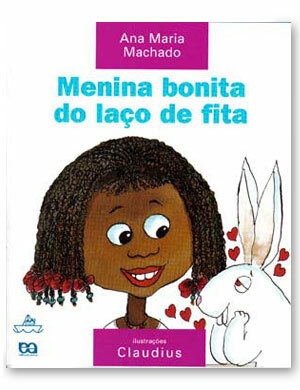
PROJECT:
KNOWLEDGE AREA: Portuguese language
STUDY OBJECT: Brazilian Ethnic-Cultural Diversity Elementary School – 1st to 5th year
INTRODUCTION: Development of the theme of diversity, not only with the aim of introducing students to the richness of Brazilian ethnic-cultural diversity, contributing for children to appropriate values such as respect for themselves and others, but also with the objective of raising the self-esteem of the black student. The suggestion is that the activities be developed for a minimum period of five days, (remembering that this suggestion of classes cannot take place in just one day) during which the teacher will:
1. Presenting the story to the class, telling it, without showing the book.
2. Ask the children to give a title (a name) to the story they heard, writing their suggestions on the board.
3. Telling that who wrote the story was Ana Maria Machado, a Brazilian writer who mainly writes books for children. If the teacher has already read other books by the author to the class, remind the students, if possible, showing them.
4. Say the title of the book: “Beautiful Girl with the Ribbon Bow” and compare it with the names presented by the students in the activity, asking them if they liked the name chosen by them better or the one chosen by the author; show children that we do not always have the same opinion about the same fact or situation and that what is important is that we learn to respect all opinions; comment on the names chosen by the students as they move away from or approach the original name of the story.
5. Show students the cover of the book. “Read” the cover image with them, asking questions about the illustration: the girl's skin color, the rabbit's, the girl's hair (who wears hair like that? is it hard to do a hairstyle like this? it takes a long time?). Highlight the bunny's passionate, thoughtful-dreamy gaze. Ask students to show what else in the illustration indicates that the rabbit is in love. Say the name of the illustrator and talk about the importance of illustration in reading.
It is important that the teacher emphasizes that in addition to being very beautiful, this heroine is also very smart and creative, because even not knowing answer the rabbit's questions, there is always a solution for it to become the desired color: drop in black ink, drink a lot of coffee, eat a lot jabuticaba…
Before reading the passage about the mother's intervention in the dialogue between the girl and the rabbit, ask if anyone remembers how she was the girl's mother.
Compare the written text (“a beautiful, smiling mulatto woman”) and the illustration of the mother, who is a beautiful, modern, well-dressed and tidy (decorated, painted, combed hair), which also helps the class to form a positive aesthetic image of women black.
7. Take advantage of the discovery of the rabbit (“we always look like parents, uncles, grandparents and even crooked relatives”) and ask students who they think they look like. This activity can unfold into others, for example:
a) children can interview parents to find out who they look like and present the survey results orally (For example, saying phrases like: My mom says my eyes look like hers, but my hair and mouth look like mine Grandfather.);
b) students can take photographs of relatives (parents, grandparents, uncles, siblings, for example); behind each photo must be the name of the child who brought it; students divide into groups of four. The photos of each group are stacked, face up; the students draw lots to see who starts playing, the first takes the first photo and tries to guess who brought it, noting the similarities between the photos and the group colleagues; if he brought the photo himself, he should shuffle the pile so that the photo comes out of first place; as long as it hits, the player will continue playing. Whoever hits the most will win the game. At the end, the children must tell their peers who the people in the photos are. Once the game is over, the teacher will ask the class the following question: are we similar to the people in our family? Was the white rabbit right in its conclusions?
8. Ask the children to draw: a) the girl with the ribbon and the mother; b) the rabbit and its new family; c) their families.
9. Organize a round of conversations. Reread the excerpt: “The rabbit thought the girl was the most beautiful person he had ever seen. And he thought: – Oh, when I get married I want to have a little black and beautiful daughter like her.” Question: What is it to be beautiful? How does a person have to be to be beautiful? There will probably be different answers from each other. Go back to what was said in activity #4 and show the children that we do not always have the same opinion on a subject and that this is very good, because the world would be very boring if everyone thought the same way and if, for example, there was only one model of beauty. Emphasize that the important thing is to respect differences. Talk to the class about the standards of beauty in “Pretty Girl”.
10. Show, on a world map, the five continents - America, Europe, Asia, Africa and Oceania, emphasizing that they are divided into countries, each one with their customs and traditions, their parties, music and dances, their religions and their way of being, because no one is equal to anyone else and that's what gives grace to life.
11. Talk to the children about the “families” (peoples) that make up Brazil: the Indians, the black, the European colonizer, the Italian immigrants, Japanese, Arabs, Jews, etc. Explain that these peoples crossed to form the large Brazilian family, which has the characteristics of its origins. Remember here the contributions of these peoples in parties, music, cooking, stories, etc.
These are just a few suggestions. The teacher must assume a posture of combating all forms of discrimination and prejudice, valuing the different ethnic groups that make up Brazil and that, in a way, are represented in the children who make up a classroom in the Education.
Finally, a highlight: to commit to working on cultural diversity and ethnicity in Kindergarten/Elementary Education, the teacher needs to be sure about what will be developed.
One way to do this is the joint reflection of teachers in pedagogical meetings, looking for answers to questions such as: Am I prejudiced? Have I ever lived in situations of discrimination or prejudice? And, regarding the black ethnicity: What do I know about the African continent? What do I know about the conditions of enslaved Africans in Brazil? What do I know about their resistance struggles, their heroes, their stories? Do I know the Zumbi story? The influence that enslaved Africans had in the formation of the Brazilian identity, in religions, festivals, songs, dances, cuisine and, mainly, stories that contribute to expand the repertoire and populate the imagination of children with positive representations of the black?
To think about:
“Our schools aim to train citizens. And citizenship does not go with inequality, just as democracy does not go with prejudice and discrimination. If children go to school, it is because we want them to fully develop as human beings…”
SOURCE: III PEDAGOGICAL SUPPORT NOTEBOOK – 2010 – RJ
Did you like it? Share this post on your social network
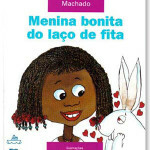 Beautiful girl in the ribbon bow - text
Beautiful girl in the ribbon bow - text
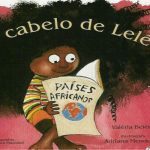 I BOOK LELE'S HAIR TO PRINT
I BOOK LELE'S HAIR TO PRINT
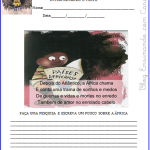 Activities About the Book: Lele's Hair
Activities About the Book: Lele's Hair
 Activities on Multiplication and Division Problems
Activities on Multiplication and Division Problems
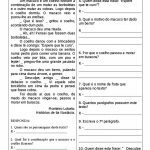 READING ACTIVITIES WITH TEXTS AND QUESTIONS
READING ACTIVITIES WITH TEXTS AND QUESTIONS
 READY CLASS PLAN OF THE BOOK “MARIA-VAI-COM-AS-OTHERS”
READY CLASS PLAN OF THE BOOK “MARIA-VAI-COM-AS-OTHERS”
it was a little difficult despite being a long activity but you learn
This site uses Akismet to reduce spam. Learn how your comment data is processed.